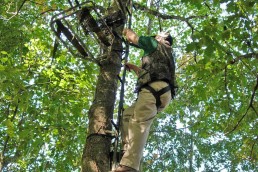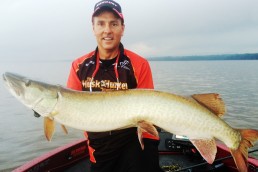Seven Steps to Early-season Bowhunting Success
SHARE THIS POST
Despite all the additions and improvements, the key to successful bow hunting is still draw, aim and release. But these seven steps for fall bowhunting success are common-sense practices that apply to all bowhunters.
Accessories popular with many hunters can enhance basic bowhunting skills; however, they are not a substitute for those skills. If you follow these suggestions this fall, you’ll be a more confident and successful hunter.
- Begin by shooting a lot. Shoot at different distances and varying angles. The quality and quantity of your practice is important. Set up a schedule and stick to it. Begin by shooting one hour per day, three days a week. Muscles used in shooting need to be strengthened with practice. Overdoing it in the early part of the practice season can result in injury. The next week, add one day or one hour to the schedule. Soon you can be shooting daily.
- Pay attention to the release of your arrows. It is important to be as smooth as possible to get correct arrow flight. In order for an arrow to be consistently accurate, it is vital that you use the same anchor point. Varying it up or down will cause the arrow to shoot high or low. If you use your jaw as an anchor point one time and the corner of your mouth the next time, the arrow will not get the same amount of energy from the release. The result is a shorter flying arrow.
As your practice schedule gets more active you will build your arm and shoulder muscles resulting in your finding it easier to draw the bow. This can allow you to pull the arrow back further than you intend and will result in more energy being transferred to the arrow. That in turn can cause the arrow to hit the target higher. Being consistent with the anchor point will keep you from overdrawing your bow.
Concentrate on drawing, aiming and releasing in one fluid motion. Soon, this will become an automatic reflex. When that big buck steps out, you will shoot correctly—automatically correctly.
Are you enjoying this post?
You can be among the first to get the latest info on where to go, what to use and how to use it!
- Every time you pick up your bow, check all the aspects that can change. Check the sight, rests, string, string serving, cables, wheels, etc. Murphy’s Law works in bowhunting, too. What can become damaged or out of adjustment will. If you make this preparation a regular part of your shooting, you will not find any surprises at the wrong time.
- Today, there are a number of foam targets on the market that are not all that expensive. Buy one and use it. The 3-D targets get you accustomed to shooting at a specific point on the animal, an important factor in hunting. But the targets with concentric circles and a bullseye can work the same, you just have to learn to envision that bullseye on the animal in the field.
- When shooting at targets, move around and shoot from various angles. If you will be hunting from a treestand, practice from an elevated location. The roof of the garage works well, as does a step ladder.
- It is important to practice on days when the weather is unfavorable, as well as nice days. Once in the field, you will not have the choice of picking the weather under which you hunt. Get to know all aspects of your hunting equipment. Shoot while wearing your hunting clothing, so that you can tell how it will adversely affect your skills. Learn how to do basic bow repairs. Things can break, and a good hunting trip will be ruined if you do not have the ability to do a repair in the field.
- If you have a second bow, take it along in the field. Practice with it as well, prior to the season opener. The bow might be the one you had before you purchased a new one. Having a backup bow can be additional insurance against having to sit in camp while others hunt. Even if you are hunting near home, the backup bow can mean not losing a weekend of hunting because you cannot get yours immediately repaired.
In short, it’s important to practice all of your hunting skills all summer, leading up to the fall hunting season. Practice and analyze your abilities as you do. Practice with the same intensity with which you hunt, and you’ll be bringing home the venison this fall.
MWO
SHARE THIS POST
Did you enjoy this post?
You can be among the first to get the latest info on where to go, what to use and how to use it!
Don Gasaway
Don Gasaway is a veteran freelance outdoor writer from Marion, Ill. He may also be found at: https://www.facebook.com/DonGasawayWriter and facebook.com/Wandering Angler. Comments are welcome



